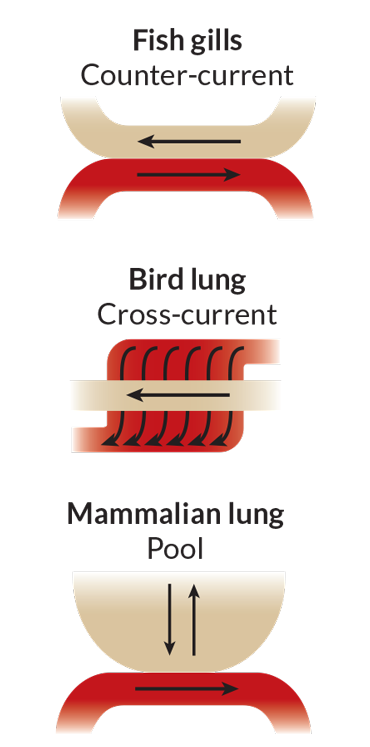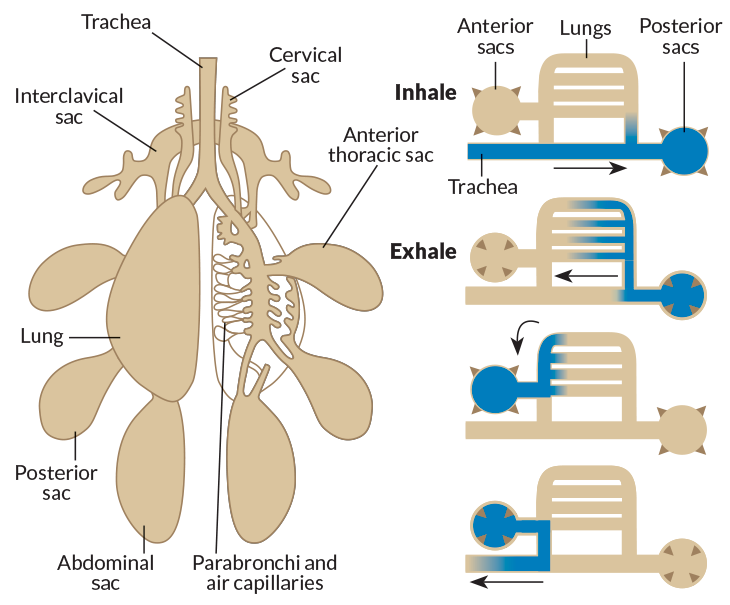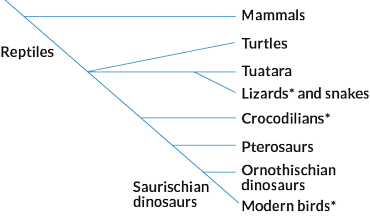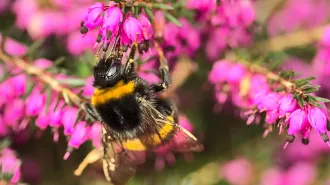Slow, cold reptiles may breathe like energetic birds
One-way airflow, thought to exist only in birds, may keep several reptiles going
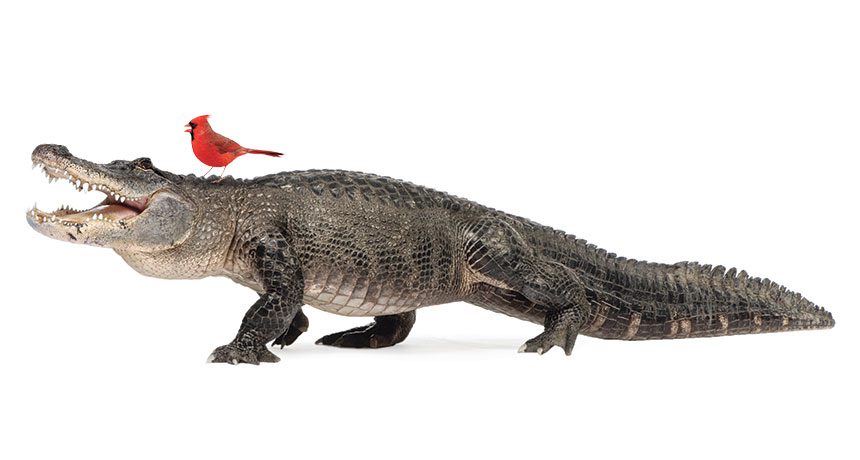
CHASING BREATH Alligators don’t fly, but a late-night notion led a researcher to show gators and birds share a breathing strategy, raising questions about other reptiles’ lungs.
chas53/iStockphoto (bird); GlobalP/iStockphoto (alligator)
Colleen Farmer was alone one night dissecting an alligator. Her focus was on blood flow in the heart, when suddenly, a hypothesis unfolded about animal lungs. In one sweep, she realized that what physiologists have assumed for decades about the evolution of airflow in alligators, other living reptiles, birds and maybe even dinosaurs might just be startlingly wrong.
Lungs sound simple: Air goes in, air goes out. But, like breathing itself, lungs are easy to take for granted and full of unexpected puzzles. In her windowless lab at the University of Utah, Farmer pondered two basic questions: Which direction does air really flow in lungs, and how did it evolve that way?
In people, air flows like the tides. Inhale, and air whooshes in. Exhale, and the air recedes along the same path, depleted of oxygen and laden with waste gas. Physiologists have believed that other vertebrates share this basic two-way tidal flow — except for birds.
Birds’ breathing was considered more efficient. There’s no downtime while used breath clears out of airways to make room for the next inhalation. Once fresh air reaches the lungs, it flows in one direction through an intricacy of loopy tubes in the crucial zones where blood vessels swap out gases. The evolution of more efficient lungs, biologists have argued, helped birds develop the metabolically expensive lifestyle of aerial athletes. Birds keep their bodies warm, regardless of the environment, and launch themselves into the skies.
There are no barrier gates or fleshy valves in bird lungs that create their remarkable one-way flow. Geometry does the trick. Quirky phenomena called “aerodynamic valves” steer air through open passageways, relying on the angles and shapes of the branching passageways.
What suddenly occurred to Farmer was that lungs of animals like alligators might have aerodynamic valves that no one had noticed. If alligators did breathe with a version of one-way lungs — and she had a hunch they would — then maybe so would other animals that neither fly nor maintain round-the-clock body warmth. If she was right, the notion that one-way lungs originated as athletic aids in birds was just a waste gas of a hypothesis.
In that extraordinary late-night moment, Farmer even thought of an alternative notion. As she described in the journal Physiology in July, one-way flow is important for gators and other ground-hugging lurkers too. “It’s about better breath-holding,” she remembers thinking.
The path of her idea from brain flash to a string of published papers has not been an aerodynamically smooth whoosh. Farmer has had to invent techniques for making measurements no one had made before, a messy process involving indoor conflagrations and theatrical supply companies. She has dealt with outright disbelief, skepticism and the intense pressures of success. Her story shows just how counter-intuitive the evolution of “simple” lungs can be.
Beachfront breathing
From the beginning, the story of vertebrate lungs is full of twists, says functional morphologist Elizabeth Brainerd of Brown University. What looks like the simplest way for something to have evolved rarely turns out to be the case. And don’t be misled by cartoons.
Caricatures of ancient fish crawling out of water onto shore have delivered plenty of speech bubbles of merriment. They conjure the appealing scenario that lungs evolved when gill-breathing fishes ventured into the terrible, suffocating air. “Wrong,” Brainerd says.
“A fish definitely did not crawl out and evolve lungs and limbs,” she says. These supposedly terrestrial traits arose tens of millions of years before any vertebrate colonized its first meter of beachfront. The creatures that eventually did the colonizing had lungs and limbs long before they nosed out of the water.
Air breathing is useful even in the water, and has arisen in some form at least 38 times among fishes, Brainerd notes. When water goes stagnant, animals that can dart to the surface for a gulp of aerial oxygen are more likely to survive. And lungs are just one of the options for aquatic air breathers. Fishes developed reservoirs inside their mouths and above their gills. Some just swallow bubbles of air that release oxygen to blood vessels in the intestines before exhaling anally.
Air breathing proved vital to surviving on dry land but that’s not what was important in its origins, Brainerd emphasizes in an overview of lung history that she wrote for the book Great Transformations in Vertebrate Evolution, published in July. Many of the great events in vertebrate history, such as leaving a water world for a dry one, relied on anatomy or physiology that had already evolved. But she cringes at overemphasizing the already evolved features as preparations, sometimes even called “preadaptations,” for some great change to come. Ancestors had simply adapted to where they lived. There was no anticipation of where they might go. Evolution, she says, “has no intentionality.”
Outsider science
Farmer’s unusual idea about evolution in lungs may have sprung from her unusual background. “I feel like an outsider in biology,” she says. As an undergraduate at the University of Idaho, she majored in physics and then worked at Lawrence Livermore National Laboratory on storage of spent fuel elements for nuclear reactors. “Oftentimes I feel like an impostor.”
Still, doing physics trained her in problem solving and was important for studying air streaming through lungs. “I think I probably had a bit better understanding of fluid dynamics than your typical biology major,” she says.
After five years in a big team, she yearned to test her own ideas. “It’s the scary part, it’s the hard part, but it’s also the exciting part of being able to do research,” she says. So she went to grad school, studying comparative physiology at Brown. A professor encouraged her to test her dogma-challenging notion about blood-flow patterns in two air-breathing fish: spotted gar and bowfin. “I’ve been thinking about hearts and lungs for half my career,” she says.
Her Utah rethink of alligator lungs came to her in an instant. But persuading the National Science Foundation to fund her development of new techniques for the work “took forever,” she remembers. Her grant proposals were “getting reviews that basically said, ‘We don’t believe you.’ ” She borrowed equipment, funded what she could personally, collected more measurements and kept submitting grant proposals.
Farmer planned to measure airflow by implanting flow sensors in live animals. Finding live alligators wasn’t hard, as long as she was willing to drive from Salt Lake City to the Rockefeller Wildlife Refuge along the Louisiana coast. She learned to pack small young American alligators in pillowcases. It keeps them “quiet and calm” for the drive back to Utah, she says. However, when she gets to the hotel, “they stay in the car.”
Story continues after sidebar
Alligator lungs don’t have some of the showier features of bird lungs. Gators don’t grow the big, flexible air sacs that pouch outward from the top and rear of lung structures, like a fringe of balloons. Many biologists have long assumed that these air sacs are what give bird-breathing its one-way route. In broad outline, when the bird inhales, air rushes down a large passageway that divides. Some air pushes immediately through a bank of skinny tubes less than 2 millimeters in diameter, where blood vessels give up their waste carbon dioxide and refresh their oxygen. The rest of the incoming fresh air sweeps into ballooning rear air sacs. The rear sacs contract and shoot the remaining air through the tiny tubes. Air leaving the tubes streams into air sacs toward the front of the lung, which are positioned so they can puff out the spent breath through the mouth-nostril front of the air passage. Aerodynamic valves prevent blowback into the oxygen-exchange tubes.
Alligator lungs may not have the same ballooning air sacs dangling from them, but their large airways loosely share some geometry with bird lungs. To see if that geometry by itself could create unidirectional flow, Farmer tested five live alligators using borrowed small sensors that can detect airflow.
Testing, testing
She remembers the first time sensors gave her a reading that air flows one way over the blood vessels in an alligator lung: “It was simultaneously exhilarating and scary,” Farmer says. “If I published something like that and it was wrong, it would be ‘cold fusion’ all over again. My career would be over.” (The University of Utah, where Farmer works, was ground zero for the exaltation and subsequent implosion of the 1989 claim that Utah chemist Stanley Pons and a colleague had achieved nuclear fusion at room temperature.)
Intensifying the pressure, NSF finally funded her — on her fifth attempt — in 2008. To see if her initially encouraging results were just artifacts of the sensors, Farmer tried a different method to test flow direction borrowed from 1940s research on bird lungs.
An ingenious professor at the University of Groningen in the Netherlands, E.H. Hazelhoff, had examined a lung from a dead crow and sluiced a soup of starch grains in clear liquid through the airways. Air and liquids follow the same laws of fluid dynamics, he pointed out in a 1943 paper. He calculated that water moving at roughly one-fifteenth the speed of air, to compensate for water’s greater density, should take the same path through a lung that air does. To trace that path, he created a little viewing window in the bird to reveal the lung and watched which way the pale starch dots moved.
Farmer tried the technique on a dead alligator, and was surprised when it worked. “I filled up a lung with water and cornstarch, and sure enough, I could see these little particles of cornstarch moving” the same way during simulated inhalation and exhalation. To submit the work to Science, she traded the down-home cornstarch for glowing microspheres. Science published the alligator paper in 2010, reporting that aerodynamic valves created one-way flow near blood vessels in alligator lungs.
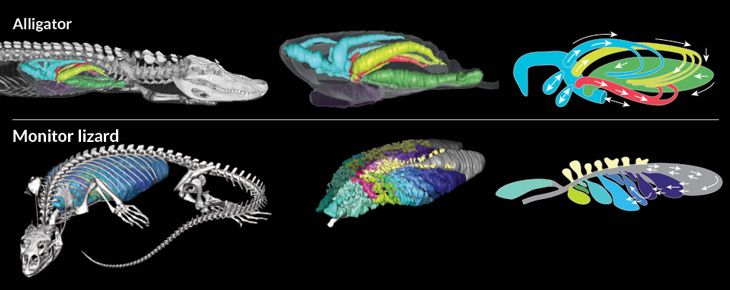
As in birds, aerodynamic valves let gators move air in and out of the same tubing at the very front end of their respiratory passages while preserving that one-way flow through tubular structures within the lung (SN: 2/13/10, p. 11). “Absolutely transformational,” Adam Summers of the University of Washington’s Friday Harbor Laboratories said at the time.
The result was surprising, but Farmer wanted to take an even more ambitious look at reptiles. On the tree of life, alligators belong to the closest living branch to birds, the crocodilians. With just an alligator and a bird, it was difficult to guess whether their ancestors had evolved one-way breathing independently or had inherited the fundamentals from some even more ancient common ancestor. Showing one-way flow in more distantly related species would suggest that an even bigger shift in thinking was needed.
So Farmer and her colleagues began testing airflow in reptiles not as closely related to birds, including a monitor lizard and the green iguana. But that required some doing.
“The techniques we were using in alligators didn’t work very well in the iguana,” Farmer says. In the narrow passageways of alligator lungs, sensors picked up a decent percentage of air flowing by. Iguana lungs have big open chambers, so sensors sampled only a small portion of the air. “Our signal-to-noise ratio was terrible,” she says. Time for a new method.
She tried building little pressure sensors that she hoped would be more sensitive than the previous flow meters. But they were too difficult to use. So she turned to endoscopes like those used by veterinarians. By inserting a scope into iguana lungs, she hoped to watch air currents sweep along particles. But first she had to find the right kind of particles and capture and direct them into the lung efficiently.
“I was burning paper, trying to get little particles of soot,” she says. “We tried cigarette smoke, which was just a nightmare.” What eventually worked was disco fog, specifically Froggy’s Fog Swamp Juice, from a theatrical supply company.
A fog machine turned the swamp juice lipid mix into persistent spooky clouds that were hard to control. So a student suggested vaporizing the liquid in an e-cigarette. “I didn’t even know what one was,” Farmer says. But the portable device, easy to hook to tubing, produces just the amount of smoke she needs. No more disco fog filling the lab.
With these technical advances, Farmer and her colleagues reported in 2013 that air flows unidirectionally through lungs of a monitor lizard (Varanus exanthematicus). In 2014, the green iguana joined the list (SN: 12/27/14, p. 12). Neither animal has a lung structure much like a bird’s.
Blow back
The papers shook up lung science. Even the first, on monitor lizards, was “truly shocking,” says vertebrate paleontologist Mathew Wedel of Western University of Health Sciences in Pomona, Calif.
“And then the iguana results came out, and they’re just ridiculous,” Wedel says. (That’s “ridiculous” in a good way.) Scientists have assumed that lungs have to be complex and highly subdivided to create the geometry of aerodynamic valves, but iguanas manage with a tube and a sac. Reading that paper was “like finding out that your kid’s tricycle can go 200 miles per hour.”
“Initially skeptical” is how John Maina of the University of Johannesburg in South Africa describes his reaction to the notion of widespread unidirectional flow. He has been studying respiratory structures for 36 years and didn’t expect lungs without the big air sacs of a bird’s lung to generate true unidirectional movement. But he has now read several of Farmer’s papers and listened to her give a talk. “The science is sound,” he says.
Steven Perry of the University of Bonn in Germany welcomes the papers as “extremely important,” although he argues with some of Farmer’s comparisons between features in birds and other species. A longtime analyst of reptile lungs, Perry has described holes between lung chambers that might allow unexpected circulation, but he didn’t argue for one-way flow. It’s still too early, he says, to call the holes in alligator lungs “parabronchi” like the features that enable one-way airflow in birds.
Farmer’s work also has implications for longtime comparisons with dinosaurs. For Wedel, they are bittersweet. “I spent roughly the first decade of my career looking for evidence of birdlike air sacs in dinosaurs,” he says. Basing that work on the old accepted wisdom, he thought he needed to find sacs, which would indicate that dinosaurs must have had birdlike airflow in their lungs. But reading Farmer’s work convinced him that he had been working under two wrong assumptions. Reptiles do not in fact need the big air sacs to streamline their airflow. Nor would the presence of one-way flow reliably indicate a metabolically expensive lifestyle like that of birds.
Finding one-way airflow in such diverse reptiles supports Farmer’s original notion that something was missing in the story of lung evolution. Alligators, monitor lizards and green iguanas — unlike birds — don’t fly and don’t rev up frantic metabolic rates to maintain a constant, warm body temperature. So, contrary to accepted thinking, perhaps unidirectional airflow is also important for the cold and slow lifestyle.
Reptiles are mostly ectotherms, animals that rely on their environment to warm or cool them. Ectotherms spend most of their lives holding their breath, Farmer says. Many hunt by just sitting and waiting. And animals can hide from prey or predators by freezing as still as stone. One-way airflow suits them. In stillness, a one-way breather can rely on the beating of its heart to jostle gases in the lungs enough to mix layers of air. And that jostling increases oxygen transmission from breath to blood vessel over what would occur by diffusion without mixing. Lungs that are shut tight during breath-holding can keep up the gas exchange more readily if air is just circulating one way, Farmer contends.
One-way air circulation may also ease the disposal of depleted air from the lungs, the process called washout, Farmer says. There’s less mixing of old and fresh breath, and thus less need for as many breaths. Less urgency in breathing can bring many economies, such as less loss of body moisture or heat.
True, one-way airflow appears to benefit today’s birds. Migrating geese can soar at low-oxygen heights and fish-hunting penguins can hold their breath on long dives for dinner. But way before such athletics evolved, some slow, chilly advantage might have driven one-way flow in their reptile ancestors. Today’s benefits don’t have to be yesterday’s. As Brainerd says, evolution has no intentions.
This story appears in the October 31, 2015, Science News under the headline, “Chasing breath: Search for one-way airflow alters lung evolutuon story.”
